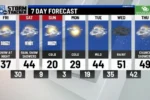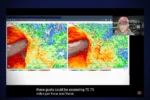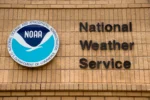On February 16, 2025, a big chill is coming to Connecticut! Governor Ned Lamont has warned everyone about a wave of freezing temperatures and strong winds that could make it feel much colder than it really is. This means that people need to be extra careful outside. To keep everyone safe, the governor has announced a special plan to help those who might need a warm place to stay. Let’s learn more about what this cold weather protocol means and how it will help people during these icy days ahead!
| Attribute | Details |
|---|---|
| Announcement Date | Friday, February 14, 2025 |
| Protocol Activation Start | 6:00 PM on February 16, 2025 |
| Protocol Activation End | 12:00 PM on February 22, 2025 |
| Expected Overnight Temperatures | Single digits |
| Wind Chill Effect | Feels like below zero |
| Shelter Contact Number | 2-1-1 or visit 211ct.org |
| Frostbite Risk | Less than 30 minutes on exposed skin |
| Emergency Management Coordination | State agencies and municipalities work with 2-1-1 and shelters |
| WebEOC Use | Real-time information exchange for shelter capacity monitoring |
| Departments Involved | Emergency Services, Social Services, Housing, Mental Health |
| Transportation Availability | Provided for individuals seeking shelter |
Understanding Severe Cold Weather Protocol
Governor Ned Lamont’s announcement about the severe cold weather protocol is crucial for Connecticut residents. This protocol activates when extremely low temperatures and harsh winds are expected, helping to protect vulnerable individuals. The state wants to ensure everyone knows about available shelters and warming centers. When temperatures drop into the single digits, it is vital for all to seek safety indoors and avoid prolonged exposure to the cold.
The severe cold weather protocol is not just about staying warm; it’s about saving lives. People can suffer from frostbite or hypothermia if they are outside for too long in freezing conditions. By activating this protocol, the state coordinates efforts to provide shelter and transportation. This means that if you or someone you know needs help, there are resources available, like calling 2-1-1 or visiting their website.
How to Stay Safe During Extreme Cold
When the weather gets really cold, it’s important to take precautions to stay safe. Dress in layers, cover exposed skin, and limit time outside. Governor Lamont warns that frostbite can happen quickly, sometimes in less than 30 minutes! Staying indoors as much as possible will help you avoid dangerous conditions. If you must go outside, make sure to wear warm clothing and keep moving to stay warm.
If you or someone you know needs shelter, remember that help is available. Connecticut has a network of shelters and warming centers that can provide a safe place to stay during extreme cold. You can reach out to 2-1-1 for information on where to find these resources. Transportation can also be arranged for those who need assistance getting to a shelter. It’s essential to take these steps to protect yourself and others.
Resources for Cold Weather Help
Connecticut has many resources in place to help residents during severe cold weather. The state works with organizations like United Way 2-1-1 to connect people with shelters and warming centers. When the cold weather protocol is active, these resources become even more important. It’s easy to find help by calling 2-1-1 or visiting their website, where you can get information about available services near you.
In addition to shelters, local officials and emergency management teams use a system called WebEOC to monitor conditions and communicate in real-time. This means that when a temporary shelter opens, it can be quickly reported to 2-1-1, ensuring everyone knows where to go. By staying informed and using these resources, you can help keep yourself and your community safe during frigid temperatures.
Understanding the Severe Cold Weather Protocol
The Severe Cold Weather Protocol is a vital initiative designed to protect vulnerable populations in Connecticut during extreme winter conditions. Activated in response to dangerously low temperatures and harsh winds, this protocol ensures that shelters and warming centers are available to those in need. By coordinating efforts between state agencies, municipalities, and local organizations, the protocol aims to minimize the risks associated with prolonged exposure to severe weather.
During the activation period, the protocol serves as a communication framework that allows emergency management officials to share real-time information effectively. This coordination helps monitor shelter availability and mobilizes resources to transport individuals to safe locations. With temperatures expected to drop significantly, this structured approach plays a crucial role in safeguarding lives and ensuring that everyone has access to essential services.
Safety Tips for Extreme Cold Conditions
As the arctic air settles in, it is essential for residents to understand the risks associated with extreme cold. Frostbite can set in quickly, particularly on exposed skin, and can cause serious injuries if not addressed promptly. It’s advisable to limit outdoor exposure and dress in layers to retain body heat. If you must venture outside, cover as much skin as possible and stay aware of the signs of hypothermia, which can include shivering, confusion, and extreme fatigue.
In addition to personal safety measures, it’s vital to check on neighbors, especially the elderly or those with limited mobility. Encourage them to seek shelter or use warming centers if they are unable to keep warm at home. Community solidarity plays a key role in overcoming the challenges posed by severe weather, and small acts of kindness can make a significant difference in someone’s safety and well-being during these frigid days.
Accessing Shelter and Warming Centers
For those in need of shelter during this severe cold weather period, Connecticut offers a comprehensive network of resources to assist individuals and families. By contacting 2-1-1 or visiting 211ct.org, residents can find information on the nearest shelters and warming centers. These facilities are designed to provide a safe and warm environment for those who might otherwise face life-threatening conditions during this arctic outbreak.
Transportation services are also available for those needing assistance reaching these shelters, ensuring that everyone has access to vital resources. Local officials are actively working to open temporary shelters as needed, and the coordination through the 2-1-1 service helps streamline this process. This collaborative approach ensures that Connecticut’s vulnerable populations receive the support they need during extreme weather events.
The Role of Community in Weather Emergencies
In times of severe weather, community involvement becomes crucial in ensuring the safety and well-being of all residents. Local organizations, volunteers, and citizens can provide invaluable support by helping to spread the word about available resources, including shelters and warming centers. Engaging with community networks, such as neighborhood associations or social media groups, can enhance communication and foster a collaborative spirit to assist those in need.
Additionally, residents can volunteer their time or donate supplies to shelters, making a tangible impact during these challenging times. Whether it’s providing warm clothing, blankets, or hot meals, every contribution helps create a more supportive environment for those affected by the harsh winter conditions. By working together, communities can build resilience and ensure that no one is left out in the cold.
Frequently Asked Questions
What does the severe cold weather protocol mean?
The **severe cold weather protocol** is a plan to help people stay safe when it gets very cold outside. It makes sure shelters and warming centers are open for those who need a safe place.
Why is it important to stay indoors during extreme cold?
Staying indoors is crucial because extreme cold can cause **frostbite**, which hurts your skin in less than 30 minutes. It can also make you very sick or even be dangerous.
How can I find a warming center if I need one?
If you need a **warming center**, you can call **2-1-1** or visit **211ct.org**. They will help you find a safe place to stay warm.
What happens if someone is stuck outside in the cold?
If someone is outside in the cold for too long, they can get very sick. They might experience **frostbite** or even **hypothermia**, which is when your body gets too cold.
How does the state keep track of shelter spaces?
The state uses a system called **WebEOC** to monitor how many shelter spaces are available. This helps them know where people can go for safety during cold weather.
What should I do if I see someone who needs help in the cold?
If you see someone who needs help, you should call **2-1-1** or tell an adult. They can arrange transportation to a shelter or warming center.
What kind of weather is expected during the cold weather protocol?
During the protocol, it is expected to be very cold, with temperatures dropping into the **single digits** and strong winds, making it feel like it’s below zero.
Summary
Governor Ned Lamont of Connecticut has activated the state’s severe cold weather protocol from 6:00 PM on February 16, 2025, until 12:00 PM on February 22, 2025, due to forecasted arctic temperatures and severe winds. Overnight temperatures are expected to drop into the single digits, potentially feeling like below zero. The protocol aims to protect vulnerable populations, providing shelter and transportation options through 2-1-1. State agencies will coordinate efforts to monitor shelter capacities and assist those in need. Governor Lamont emphasized the dangers of frostbite and the importance of seeking shelter during these extreme conditions.







